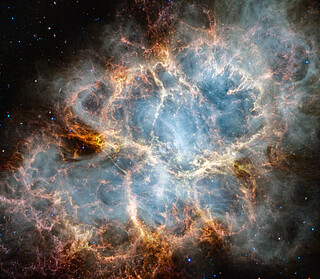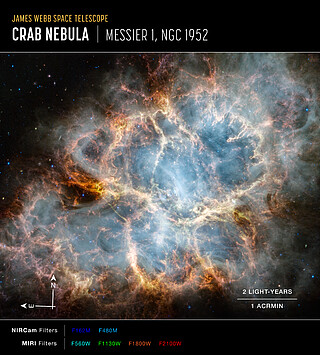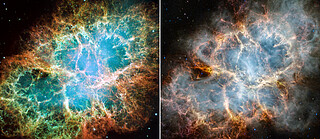weic2326 — Photo Release
The Crab Nebula Seen in New Light by Webb
30 October 2023
Although the Crab Nebula is one of the best-studied supernova remnants, questions about its progenitor, the nature of the explosion that created it still remain unanswered. The NASA/ESA/CSA James Webb Space Telescope is on the case as it sleuths for any clues that remain within the supernova remnant. Webb’s infrared sensitivity and spatial resolution are offering astronomers a more comprehensive understanding of the still-expanding scene.
The NASA/ESA/CSA James Webb Space Telescope has gazed at the Crab Nebula, a supernova remnant located 6500 light-years away in the constellation Taurus. Since this energetic event was recorded in 1054 CE by 11th-century astronomers, the Crab Nebula has continued to draw attention and additional study as scientists seek to understand the conditions, behaviour, and after-effects of supernovae by carefully studying this relatively close example.
With Webb’s NIRCam (Near-Infrared Camera) and MIRI (Mid-Infrared Instrument), the game is afoot as new details are uncovered—including the first complete map of dust distribution—in the search for answers about the Crab Nebula’s origins.
At first glance the general shape of the nebula is reminiscent of the 2005 optical wavelength image from the NASA/ESA Hubble Space Telescope. In Webb’s infrared observation, a crisp, cage-like structure of fluffy gaseous filaments are shown in red and orange. However, in the central regions, emission from dust grains (yellow-white and green) is mapped out by Webb for the first time. The Hubble and Webb images of this object can be contrasted here.
Additional aspects of the inner workings of the Crab Nebula become more prominent and are seen in greater detail in the infrared light captured by Webb. In particular, Webb highlights what is known as synchrotron radiation: emission produced from charged particles, like electrons, moving around magnetic field lines at relativistic speeds. The radiation appears here as milky smoke-like material throughout the majority of the Crab Nebula’s interior.
This feature is a product of the nebula’s pulsar, a rapidly rotating neutron star. The pulsar’s strong magnetic fields accelerate particles to extremely high speeds and cause them to emit radiation as they wind around magnetic field lines. Though emitted across the electromagnetic spectrum, the synchrotron radiation becomes particularly vibrant in the infrared with Webb's NIRCam instrument.
To locate the Crab Nebula’s pulsar heart, trace the wisps that follow a circular ripple-like pattern in the middle to the bright white dot in the centre. Further out from the core, follow the thin white ribbons of the radiation. The curvy wisps are closely grouped together, outlining the structure of the pulsar’s magnetic fields, which sculpt and shape the nebula.
At centre left and right, the white material curves sharply inward from the filamentary dust cage’s edges and goes toward the neutron star’s location, as if the waist of the nebula is pinched. This abrupt slimming may be caused by the confinement of the supernova wind’s expansion by a belt of dense gas.
The wind produced by the pulsar heart continues to push the shell of gas and dust outward at a rapid pace. Notice how the filaments tend to be longer toward the upper right side of the nebula, in the same direction the pulsar is moving – not restricted by the belt of gas. Among the remnant’s interior, yellow-white and green mottled filaments form large-scale loop-like structures, which represent areas where dust grains reside.
The search for answers about the Crab Nebula’s past continues as astronomers further analyse the Webb data and consult previous observations of the nebula taken by other telescopes. Scientists will have newer Hubble data to review within the next year or so from the telescope’s reimaging of the supernova remnant. This will mark Hubble’s first look at the Crab Nebula in over 20 years, and will enable astronomers to more accurately compare Webb and Hubble’s findings.
More information
Webb is the largest, most powerful telescope ever launched into space. Under an international collaboration agreement, ESA provided the telescope’s launch service, using the Ariane 5 launch vehicle. Working with partners, ESA was responsible for the development and qualification of Ariane 5 adaptations for the Webb mission and for the procurement of the launch service by Arianespace. ESA also provided the workhorse spectrograph NIRSpec and 50% of the mid-infrared instrument MIRI, which was designed and built by a consortium of nationally funded European Institutes (The MIRI European Consortium) in partnership with JPL and the University of Arizona.
Webb is an international partnership between NASA, ESA and the Canadian Space Agency (CSA).
Image Credit: NASA, ESA, CSA, STScI, T. Temim (Princeton University)
Links
- ESA Webb Seeing Farther Interactive Brochure
- Release on STScI website
- Release on ESA website
- Release on NASA website
Contacts
Bethany Downer
ESA/Webb Chief Science Communications Officer
Email: [email protected]
Ninja Menning
ESA Newsroom and Media Relations Office
Email: [email protected]
About the Release
| Release No.: | weic2326 | |
|---|---|---|









